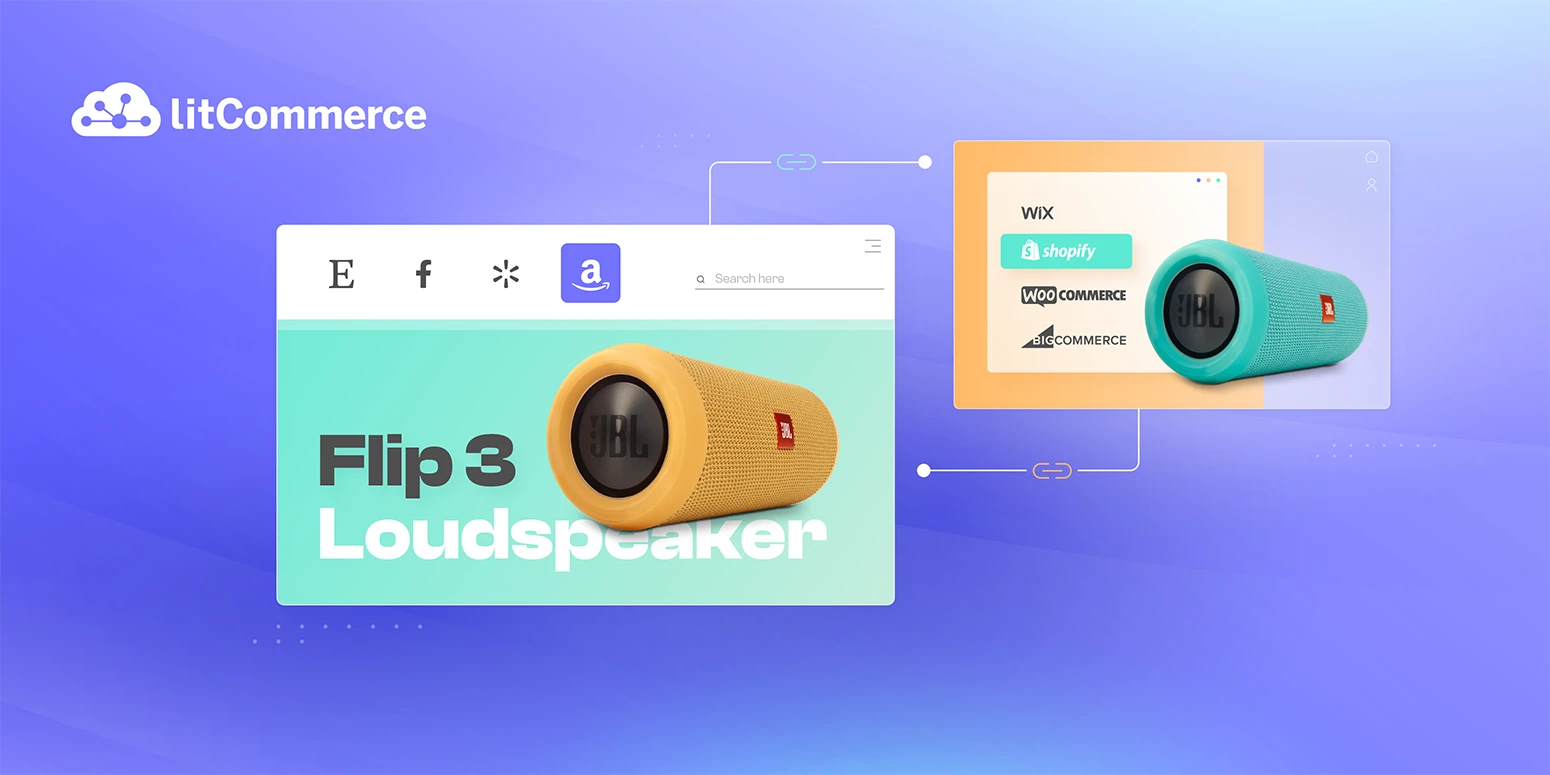Without a doubt, an eCommerce marketplace integration is a strategic approach that allows online retailers to connect their online store with various popular marketplaces like Amazon, eBay, and Etsy. This integration enables sellers to expand their reach, tap into a larger customer base, and boost sales potential. But is this notion comprehensive enough for you?
If you still find the concept of eCommerce integration vague, the following topic is a must-read. In this article, you are about to uncover:
- What is marketplace integration?
- How does marketplace integration benefit you?
- How does this integration work?
- What are your best tools to integrate marketplaces?
Without further ado, let’s jump right into it!
Expand Your Business by Integrating Multiple Marketplaces!
Use LitCommerce to connect your online store with various marketplaces at once. Streamline your operations and increase your sales today!
What is eCommerce Market Integration?
eCommerce market integration is a broader business strategy that connects all your online sales channels, including your eCommerce store, online marketplaces, and other digital platforms, into a single, unified system.
Instead of managing each marketplace or website separately, eCommerce market integration ensures that every channel communicates with one another. Product listings, stock levels, customer data, and order information flow seamlessly across all connected systems. For example, when an item sells on your Shopify store, the inventory is instantly updated on Amazon, eBay, and even your physical store’s POS system.
This level of integration goes beyond simple marketplace syncing. It helps create a connected ecosystem where your eCommerce platform, fulfillment center, and marketing tools all work together. The result is a smoother workflow, consistent data accuracy, and a better shopping experience for your customers — no matter where they find your products.
In short, marketplace integration connects your store to one marketplace, while eCommerce market integration connects your entire sales network into one cohesive system.
What Are The Benefits of eCommerce Marketplaces Integration?
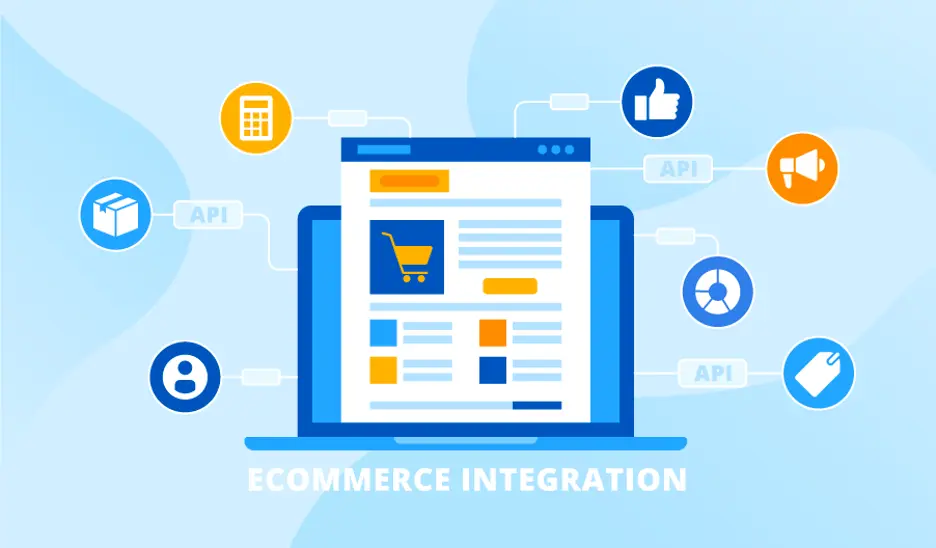
An eCommerce marketplace integration is crucial for sellers looking to streamline operations and optimize their selling potential. It eliminates the need for manual data entry by automating inventory management, order fulfillment, and product syncing, saving time and reducing the risk of errors.
Right below is a deeper glance at the advantages of integrating marketplaces and eCommerce platforms.
- Reduce manual information processing: Manual information processing, such as entering data from different sales channels, won’t be time-consuming and error-provoking once you integrate marketplaces. Notably, if you use a marketplace integrator, most information processing tasks and technical issues will be lifted by the provided system.
- Simplify multichannel selling procedure: Marketplace integration is conducted automatically and allows you to manage all sales channels from one central dashboard. Accordingly, selling on multiple platforms with a greatly simplified procedure is much easier.
- Expand to a new audience: You probably limit your audience reach when showcasing products or services on one sales channel. On the other hand, if you go live on more marketplaces, such as eBay or Amazon, you may expand to billions of new customers with incredible traffic and high buying intent.
- Increase accessibilities through search engines: Generally, most marketplaces have advanced search algorithms to support sellers’ visibility on search engines, which is a huge benefit. Adding to that, reports reveal that more than 80% of online shoppers search for items online before purchasing. Hence, why not choose to integrate marketplaces now?
- Enhance customers’ trust: Marketplaces like Amazon, eBay, or Etsy have established a high sense of reliability. Based on that, listing your products on such sales channels helps them appear more trustworthy and legitimate to potential buyers.
- Save resources through automation: By using automated marketplace integrators, you can save time, money, and human resources. Should you be running startups or small-scale businesses, you surely need that.
Understanding marketplace integration gives you a broader view of how different sales channels connect and sync to streamline your ecommerce operations. Once you grasp these fundamentals, it becomes easier to apply them to specific platform combinations and improve your multichannel workflow. For a practical example, explore our Wix–Etsy integration to learn how to seamlessly link these two platforms and simplify your cross-channel selling.
How Does eCommerce Marketplace Integration Work?
You have just walked through the definition of eCommerce marketplace integration and its benefits. Now, it is time to figure out how eCommerce integration works.
eCommerce Marketplace integration works by using an automated system or connector to synchronize all your store’s essential data across different platforms. Once connected, this system ensures product listings, inventory levels, prices, and order details update in real time between your online store and the marketplaces.
For example, when a customer places an order on Amazon, the system automatically updates your store inventory and order records. Similarly, when you adjust a price on your main website, it instantly reflects on all linked marketplaces.
This real-time communication prevents overselling, reduces errors, and gives you centralized control over all sales channels without switching between dashboards. Essentially, it’s automation doing the heavy lifting so you can focus on growth, not manual tasks.
Types of eCommerce marketplace integration
- Marketplace API integration: The first method of marketplace integration is API integration. This integration method is to connect two or more selling platforms using their APIs. The API key is a code that identifies and authenticates users or contentful apps. As soon as you conduct API integration among multiple channels, you allow data from each to be exchanged and synced.

- CSV file import integration: For those online merchants who don’t have a store on the eCommerce platform, you can implement marketplace integration through CSV file import (file-based integration). A CSV (comma-separated values) file is simply a text file containing all your products’ data. In this situation, the CSV file will act as the input data; you only have to import the file into a marketplace integrator. After you have completed importing, you can connect multiple channels easily.
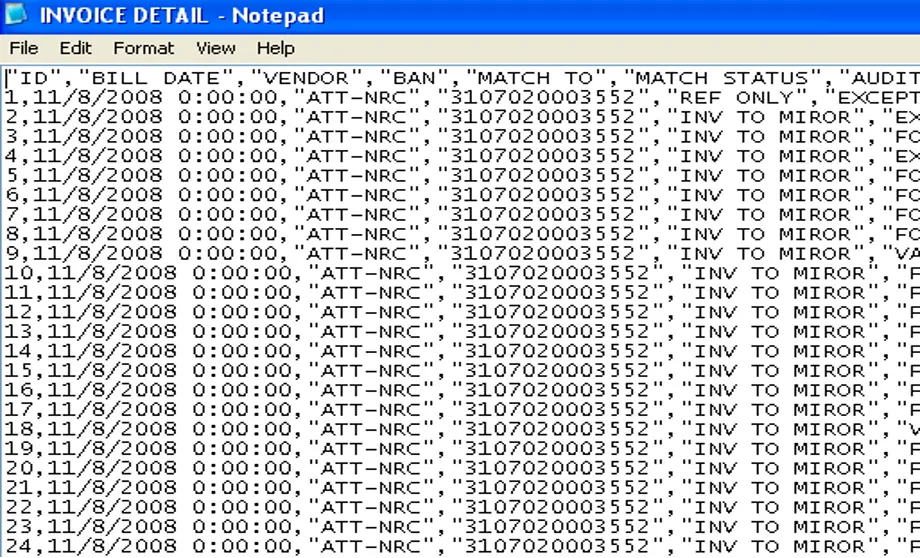
5 steps of eCommerce marketplace integration
Here’s a simplified breakdown of how marketplace integration typically unfolds:
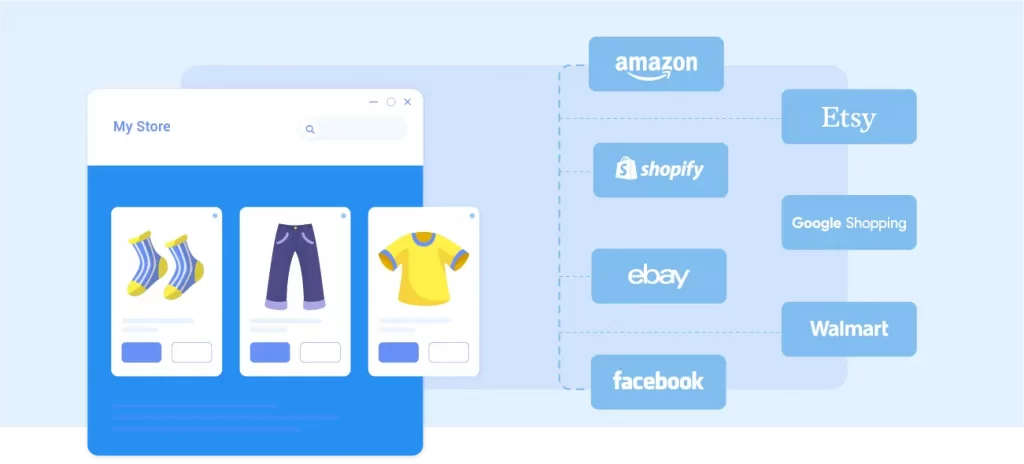
#Step 1: Choose an integration tool
The foundation of a successful integration starts with choosing a reliable tool. Your integration platform should support both your eCommerce store (Shopify, WooCommerce, BigCommerce, etc.) and your desired marketplaces (Amazon, Etsy, eBay, Walmart, etc.).
A good integration solution, like LitCommerce, offers built-in connectors for multiple platforms, a simple setup process, and real-time synchronization. It also provides scalability — so as your business grows, you can easily add new channels without starting from scratch.
When choosing a tool, also consider essential factors like customer support, data security, pricing flexibility, and whether it offers features such as bulk editing, performance analytics, and automatic order routing.
#Step 2: Connect your store and marketplaces
Once you’ve selected your integration platform, the next step is establishing a secure connection between your online store and your chosen marketplaces. This typically happens through an API connection, which allows the two systems to communicate automatically.
During this setup, you’ll authorize the integration tool to access product data, inventory levels, and order information from your store. This connection ensures that the tool can sync updates across platforms without manual input.
For example, with LitCommerce, you can connect your Shopify store and Amazon account in just a few clicks. After authorization, the system automatically pulls your products into the integration dashboard, ready for syncing and publishing.
#Step 3: Sync your product listings
With your store and marketplaces connected, it’s time to prepare and sync your product data. This step involves mapping your store’s product attributes, such as titles, images, SKUs, categories, and descriptions, to each marketplace’s listing format.
Because every marketplace has unique listing requirements, your integration tool will help align your existing data to meet those standards. You can also use bulk-upload options to publish hundreds of listings simultaneously instead of doing it one by one.
At this stage, it’s also smart to optimize your listings. Adjust product titles for SEO, use high-quality images, and add relevant keywords or tags that appeal to each marketplace’s audience. Proper optimization improves visibility and helps your products rank higher in search results.
#Step 4: Enable real-time updates
Once your listings are published, real-time synchronization becomes essential to keep everything consistent. This means that any change you make in your store, whether it’s updating stock levels, modifying prices, or changing product details, is automatically reflected on all marketplaces.
This constant two-way sync helps prevent overselling, duplicate listings, and outdated information. For example, if one unit of a product sells on eBay, your inventory on Shopify and Amazon instantly decreases by one as well.
Note: To guarantee all data is updated on time, you should check if marketplace integration has data sync.
#Step 5: Manage from one central dashboard
After everything is connected and synced, you can take full advantage of centralized management. A single dashboard lets you track all orders, view inventory across every platform, and even analyze performance metrics, all in one place.
From here, you can fulfill orders, print shipping labels, or update tracking details without switching between different marketplace accounts. Some tools even allow bulk order processing and automated rule-based workflows (e.g., auto-accept or auto-cancel orders).
In addition, the dashboard provides a unified view of your sales data, helping you identify which channels are performing best and where to optimize your listings. This centralized control not only saves time but also makes scaling your business across new marketplaces effortless.
3 Best eCommerce Marketplace Integration Tools
Since we have comprehended the concept of online eCommerce marketplace integration, let’s look into the best integrators for online merchant on the market at the moment.
#1. LitCommerce
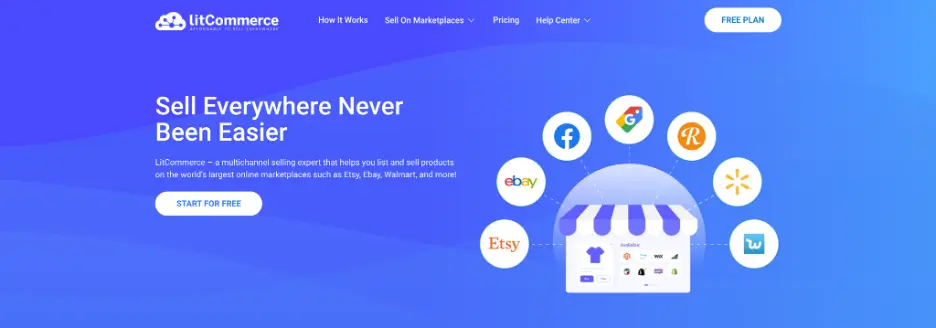
Developed by the reputable shopping cart migration expert – LitExtension, LitCommerce is rising as a powerful multichannel selling solution. In general, LitCommerce allows selling across multiple channels with ease and affordability.
When using this app, sellers are likely to benefit from the following impressive features:
- Multichannel Connect: The multichannel connect feature makes it easy to integrate different platforms all at once. Especially, no technical expertise is required!
- LitCommerce QuickGrid: This is a spreadsheet-style interface that lets you edit listings on a central screen. In addition, you may edit products individually or in groups. Besides, the app enables you to bulk update products using LitCommerce’s Templates and Recipes.
- LitCommerce LiveSync: The third feature creates almost instant sync among pricing, inventory, and orders from your integrated marketplaces. Once you switch on the LiveSync function, overselling or out-of-stock problems are no longer your concerns.
- Integrated Order Flow: As you turn on the Integrated Order Flow, all existing orders from any marketplace will be pulled into your eCommerce platform’s dashboard. From there, you can choose to review orders before fulfilling them or have LitCommerce import directly into your existing order flow. Afterward, it is time for centralized multichannel fulfillment.
LitCommerce pricing tiers start from $29/ month, and you can get a 7-day free trial with full features access. Therefore, if you are unsure about this solution, you can still experience it without spending anything!
Simplify Your Marketplace Integration with LitCommerce
Easily connect Amazon, eBay, Etsy, and TikTok to your online store with LitCommerce. Sync your inventory seamlessly and boost your sales today!
#2. Sellbrite
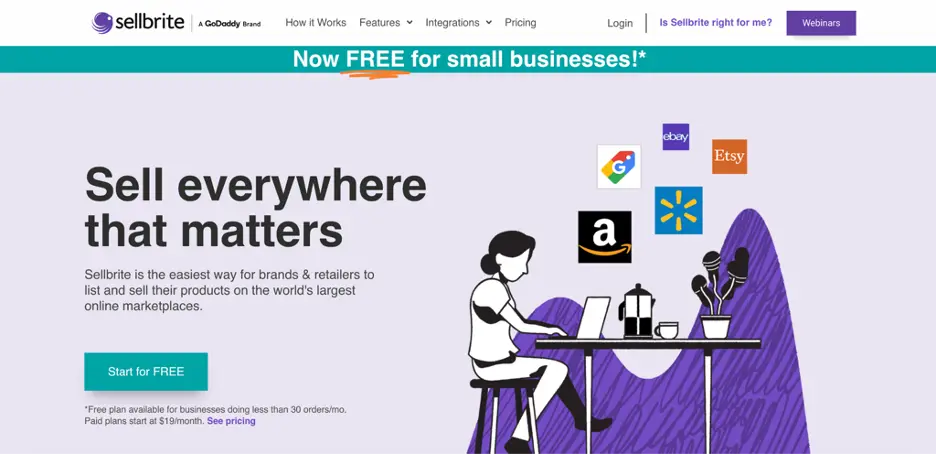
Talking about online eCommerce platform integration, Sellbrite is a multichannel selling tool that helps small to medium businesses connect their online store to marketplaces. Overall, Sellbrite will simplify the selling procedures and let users manage pricing, inventory, etc., from a centralized seller hub. Moreover, Sellbrite provides sellers with reports and analytics for performance tracking, which may help with further conducts within a business.
Sellbrite’s pricing tiers start at $0/ month, but its free plan barely has a sense of functionality. Therefore, Pro 100 ($29/ month) is the lowest milestone sellers may kick-off. Keep in mind that this plan only suits you if you have 100 orders per month. If your orders exceed 100, Pro 500 or Pro 2K will fit you more.
#3. CedCommerce
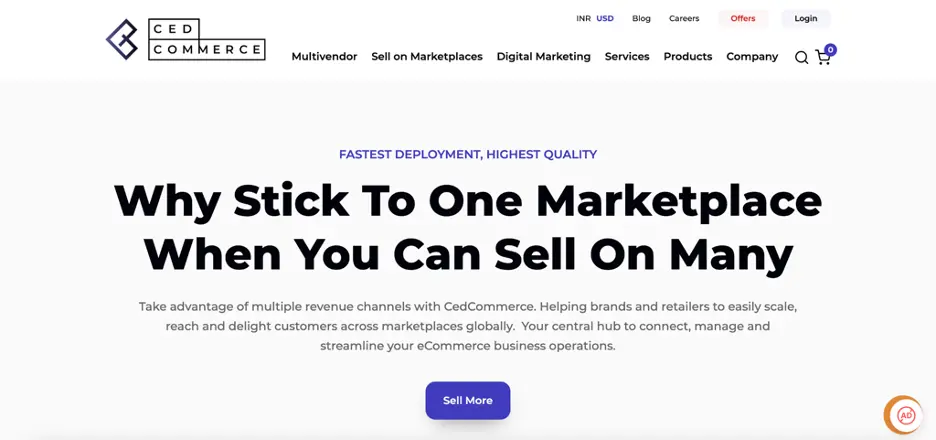
Last but not least, CedCommerce is an all-in-one and contentful plugin to integrate marketplaces with eCommerce stores.
Discussing it further, CedCommerce is well-known for its user-friendly interface and a wide of tools for eCommerce businesses to conduct marketplace integration. Besides, this integrator has features for pricing, inventory, and order management.
CedCommerce pricing plans vary from $0 to $259 per month. The most recommended tier is Standard (for 300 orders/ month). Meanwhile, their free plan has a limit of 10 orders. On the other hand, if you are running a medium-scale business, you will need to go for higher pricing tiers.
eCommerce Marketplace Integration: FAQs
- 1. What is marketplace integration?
Marketplace integration is a process of connecting eCommerce stores with other marketplaces. Once the integration begins, it will allow data synchronization among all connected platforms.
- 2. What is a marketplace integrator?
A marketplace integrator (also known as a marketplace connector) refers to an automated system that carries out the integration process and takes care of technical tasks. Moreover, a marketplace integrator can come in the form of plugins or apps.
- 3. What are the advantages of marketplace integration?
Here are the six outstanding advantages of integrating marketplaces:
- Reduce manual information processing
- Simplify the multichannel selling procedure
- Expand to new audience
- Increase accessibility through search engines
- Enhance customers’ trust
- Save resources through automation
- 4. Why eCommerce marketplace integration is important for multichannel sellers?
Ecommerce marketplace integration is crucial for multichannel sellers because it allows them to sell across many platforms at once. Not to mention, exposure to new marketplaces and segmentations is likely to lead to a rise in sales potential.
Finally, eCommerce marketplace integration will likely save resources and reduce the risk of errors during the multichannel selling process.
- 5. What are the features to look for in a marketplace integrator?
- A centralized dashboard to manage stores: A marketplace integrator should always provide a single dashboard where you can monitor inventory numbers and new orders received, dispatch those orders, or modify the product.
- Real-time synchronization: Real-time synchronizations between the connected platforms are important. It ensures that all the figures, including Inventory numbers, Orders, and Product Details, are updated on all ends in real-time.
- Automated cron: When integrating with the eCommerce marketplaces, you’ll have the option of using automated cron jobs to eliminate manual mistakes. Specifically, a cron is a series of instructions or commands that inform the server to run a pre-defined procedure in a pre-determined time.
- Multi-listing management: As part of eCommerce marketplace integration, you should be able to bulk-upload and manage items on your shop and marketplace.
- Unified orders management: As you integrate marketplaces, you should be able to accept, reject, ship, and remove orders from a single spot. Furthermore, as you use a marketplace integration system, you can set an advanced option to acknowledge orders received on the orders automatically.
- Multiple user accounts: Another perk of marketplace integration is that it allows multiple user accounts to manage connected sales channels in a streamlined manner. Also, the function can be useful when the same marketplace is operating in different countries.
- Live notifications: With real-time alerts, you’ll never be out of the loop. With the eCommerce marketplace connection, vendors can keep track of new orders, rejected orders, low inventory statistics, and more.
The Bottom Line
The benefits of eCommerce marketplace integration are immense. It allows sellers to leverage the vast customer base and established infrastructure of popular marketplaces, increasing visibility and driving sales. The integration also provides centralized control and real-time data synchronization for efficient management across platforms.
Hence, if you are ready to unlock the next chapter of multichannel selling, why not give it a try? When integrating different marketplaces, you can use LitCommerce as your supporter. We are always honored to become your accompany!
In case you are on your way to learning about eCommerce, check out our Retailer Blog and join the LitCommerce Facebook community to update the latest news and insights in this field.
Lastly, don’t hesitate to contact us if you have more questions about eCommerce or multichannel selling. We are always here to help!

